 As the owner of a contract manufacturing or job shop, you may spend a lot on the phone asking potential buyers questions about what they need. In fact, you most likely have a mental checklist of what to ask and jot answers into a notebook (or worse, scraps of paper).
As the owner of a contract manufacturing or job shop, you may spend a lot on the phone asking potential buyers questions about what they need. In fact, you most likely have a mental checklist of what to ask and jot answers into a notebook (or worse, scraps of paper).
Depending on your business, you may need people to send you a CAD file before you can give a quote for the job or part to be produced, so that becomes part of your process, too.
Over the last two years, I’ve made it a point ensure the websites Rachel Cunliffe, of Cre8d Design, and I create help our manufacturing clients improve their sales processes. One thing we’ve done is help our clients move their paper-based RFQ process to a digital format — aka the RFQ form.
In this post, I highlight a few of the RFQ forms Rachel and I have created for our manufacturing clients. I also give strategies for creating forms that improve the efficiency of your sales process and enhance your buyers’ online experience.
K2 Castings — Wear Parts for Metal Shredders
http://www.k2castings.com/contact/request-quote/
Tom Stanek, founder and President, wanted a form where people could download drawings of the part/s needed, take measurements, and then either write in the dimensions on the drawing and upload it to the form or add the dimensions to the form itself.
He also wanted to make it easy for people to upload photographs of the parts they were already using to show if the part was wearing unevenly.
Figure 1 shows how buyers can click radio buttons for the type of wear part needed. Clicking one of the buttons makes the Template Item link appear (Figure 1). The buyer can then download the template and use it to take measurements of the wear part (Figure 2).
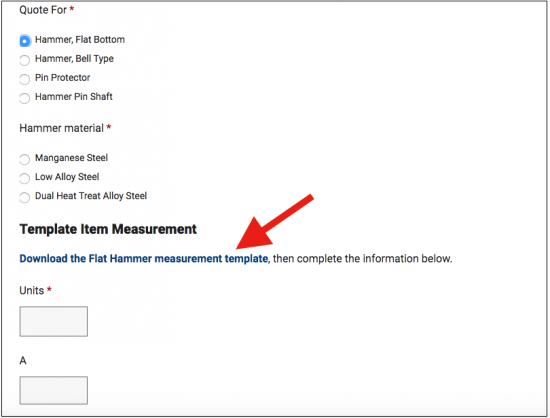
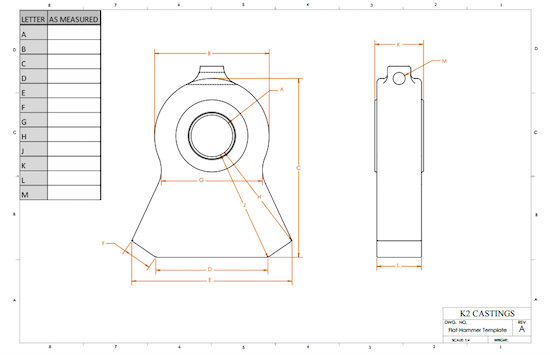
This form solves many challenges for Tom and his customers. Customers can easily measure their wear parts (which are huge!) using Tom’s detailed drawings. If a customer doesn’t have a scanner (and thus can’t upload the drawing), he/she can easily add the part dimensions to the form.
On the flip side, Tom gets the information he needs to begin the quoting process and can call the buyer / customer if he has any questions.
Urethane Innovators — Custom Urethane Molding
The more Rachel and I work with manufacturers, the more we learn, and the better our work over time — and with Urethane Innovators, you can see how the RFQ form has become more sophisticated.
This form includes detailed drawings in the form itself. Users click a radio button under “Part Type” and a drawing appears showing people how to measure the part (Figure 3), as well as fields for adding the dimensions.
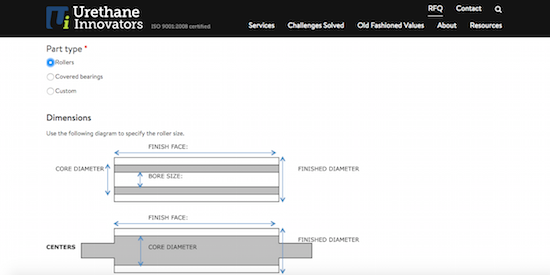
Knowing the hardness of the urethane part to be produced is important to UI for quoting purposes. A question on the form asks, “Do you know the durometer?” If the person answers “No,” another set of questions opens up (Figure 4) — a nice example of conditional form functionality.
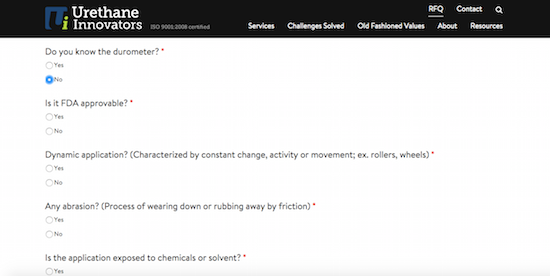
The RFQ form should improve your sales efficiencies
The RFQ form shouldn’t be confused with the more generic Contact Us form. A Contact Us form is really for general inquiries and should be as short as possible — name, email or phone, and the comment / question box. I recommend to my clients they keep the two forms separate.
It takes thought and skill to convert a paper RFQ process into a web-based form. Done well though, the online form should improve the efficiency of your sales process, which is why the RFQ form should work in tandem with your sales process. It should also improve your sales efficiencies.
If you have salespeople on the road, for example, they can easily direct customers to the form while on a sales call — or fill it out themselves while talking with the customer and using a smartphone or tablet.
If you have someone in-house who takes sales calls (or that person is you), he/she/you can direct people to the form and walk buyers through it while on the phone.
For both scenarios, it helps to have an easy to remember URL, such as “domainname.com/rfq.”
The RFQ form doesn’t replace phone / email contact information
Due to training my clients to track their inquiries and analyzing the data, I’m learning buyers will bypass the RFQ form and simply email the job shop or manufacturer. And yep, people still use the telephone, too; in fact, one of my clients still receives faxes!
To help make it easy for buyers to contact our clients by phone, email or form submission, Rachel and I now include a large call to action box at the footer of each page of a website. In Figure 5, you can see the call-to-action for Appli-Tec, providers of pre-mixed and frozen adhesives.
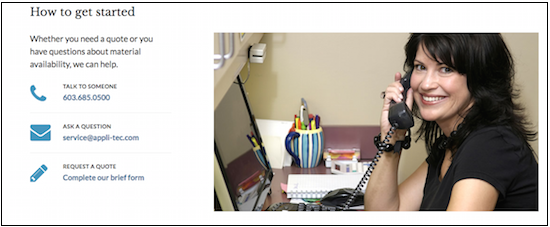
This saves the buyer having to click around to the “Contact Us” page. No matter which page they’re on, a quick click on the “email” button lets them send an email and get back to work.
Buyers don’t like long forms
Lots of debate exists on whether forms should be short or long. According to data from the Huff/Komarketing 2015 B2B Website Usability Report, 69% of survey respondents are deterred by long forms — including forms where they expect to be contacted, such as RFQ forms.
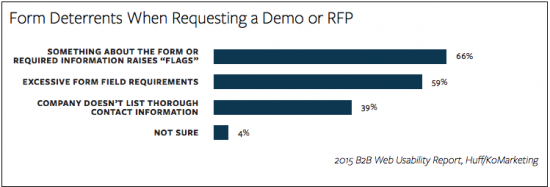
However, long forms do have their purpose, depending on the service you provide and your business.
For Urethane Innovators, the salesperson and engineer putting together the quote need to know a great deal of information because much of what UI does is custom — and including tooling, molds, etc. — hence, their form is longer.
For Tom at K2 Castings, his form is considerably shorter because he sells semi-standard parts.
If you need to create a longer form, focus on the user experience and make it super easy for people to quickly enter information. Rachel Cunliffe advises that you provide potential answers to questions where possible, versus fill-in-the-blank fields. You can also set up certain fields to “self verify” (e.g. accept numbers in a certain range).
And, based on the survey data, I recommend you ask customers and people outside of your company to test the form to ensure it’s not giving off any “red flags” that would deter people from filling it out.
Consider adding a “How did you hear about us?” field
One question I used to add to all my forms (but eventually eliminated due to the B2B Website Usability Report data cited) was “How did you hear about us?”
Cory Ploessl, marketing manager for European Home, the North American distributor for Element4 gas fireplaces, has included this field — which I really like! As you can see in Figure 7, he’s included a list of his marketing channels.
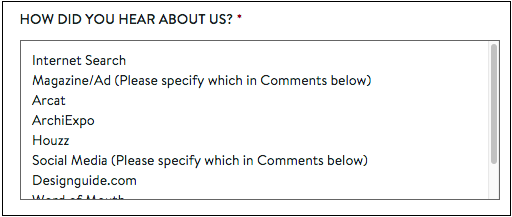
You can also make the field for this question a comment box and let people type in their response.
By asking people how they found your company, you begin to learn which marketing channels work for you. You should also be asking the “How did you hear about us?” question of everyone who calls or emails your company!
Analyze your RFQ form data
The additional benefit of having an online RFQ form is that it gets you to systemize and standardize your RFQ process so that all information is collected properly. Rachel, her brother Stephen Merriman, and I rely on Gravity Forms, a powerful WordPress plugin, for our clients’ RFQ forms.
The form and how it’s formatted is based on the initial interviews I do with clients regarding their sales process. Rachel and Stephen then create the custom form, along with adding things such as dimensional drawings.
Once the website is live, I then begin analyzing data for those clients who have retained me through my Annual Marketing Consulting Program.
Analyzing the form data is very easy: you simply log into the WordPress backend and export the data. You can export by date range as well as select specific fields to analyze.
You can use Gravity Forms to create custom forms for multiple marketing campaigns and digital channels, including pay-per-click. By creating unique forms, it’s very easy to see which campaigns are getting the best conversions — giving you actionable data on which to base marketing decisions, including where to put your marketing dollars.
If you’d like to talk about how to improve your website, or hiring Huff Industrial Marketing to help you better manage your marketing and SEO efforts — and see improved results over time — book a call to discuss. Or, simply pick up the phone and call: 603-382-8093.
